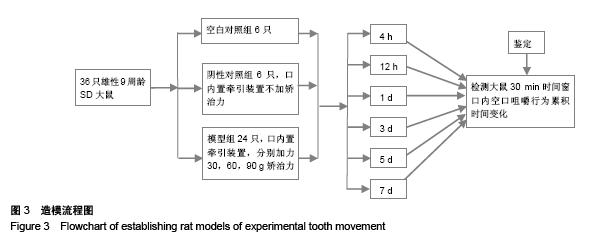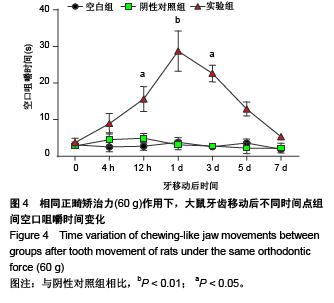| [1] Rhudy JL, Meaghel MW. Fear and amdety: divergent effects on human pain thresholds. Pain. 2000;84(1):65-75.
[2] Jones M, Chan C. The pain and discomfort experienced during orthodontic treatment: a randomized controlled clinical trial of two initial aligning arch wires. Am J Orthod Dentofacial Orthop. 1992;102:373-381.
[3] Zhang CD, Teng R, Lu Z, et al. Expression of TRPV1 and CGRP in rat trigeminal ganglion during orthodontic tooth movement. Shanghai Kou Qiang Yi Xue. 2015;24(1):6-12.
[4] Meng R, Song M, Pan J. Rho is involved in periodontal tissue remodelling with experimental tooth movement in rats. Arch Oral Biol. 2015;60(6):923-931.
[5] Li H, Gu Z, Wu L, et al. Danggui-shaoyao-san, a traditional Chinese medicine prescription, alleviates the orthodontic pain and inhibits neuronal and microglia activation. Chin Med J (Engl). 2014;127(20):3630-3637.
[6] Furstman L, Bernick S. Clinical considerat ions of tperio-dontium. Am J Orthod. 1972;61:138-155.
[7] Kato J, Wakisaka S, Kurisu K. Immunohistoch emical changesin the distribution of nerve fibers in the periodontal ligament during an experimental tooth movement of the rat molar periodontal ligament. Acta Anat (Base l). 1996;157: 53-62.
[8] Venkataramana V, Kumar SS, Reddy BV, et al. Administration of bisphosphonate (ibandronate) impedes molar tooth movement in rabbits: a radiographic assessment. J Pharm Bioallied Sci. 2014;6(Suppl 1):S165-S170.
[9] Salomão MF, Reis SR, Vale VL, et al. Immunolocalization of FGF-2 and VEGF in rat periodontal ligament during experimental tooth movement. Dental Press J Orthod. 2014;19(3):67-74.
[10] Al-Naoum F, Hajeer MY, Al-Jundi A. Does alveolar corticotomy accelerate orthodontic tooth movement when retracting upper canines? A split-mouth design randomized controlled trial. J Oral Maxillofac Surg. 2014;72(10): 1880-1889.
[11] Giannopoulou C, Dudc A, Kiliaridis S. Pain discomfort and crevicular fluid changes induced by orthodontic elastic separators in children. J Pain. 2006;7:367-376.
[12] Hakami Z, Kitaura H, Kimura K, et al. Effect of interleukin-4 on orthodontic tooth movement and associated root resorption. Eur J Orthod. 2015;37(1):87-94.
[13] Li F, Li G, Hu H, et al. Effect of parathyroid hormone on experimental tooth movement in rats. Am J Orthod Dentofacial Orthop. 2013;144(4):523-532.
[14] Aghili H, Moghadam MG, Yassaei S, et al. Effect of tramadol at different doses on orthodontic tooth movement and bone resorption in rats. Dent Res J (Isfahan). 2013;10(3):337-342.
[15] Wolf M, Lossdörfer S, Craveiro R, et al. Regulation of macrophage migration and activity by high-mobility group box 1 protein released from periodontal ligament cells during orthodontically induced periodontal repair: an in vitro and in vivo experimental study. J Orofac Orthop. 2013;74(5): 420-434.
[16] Wang M, Sun L, Yu SB, et al. Degenerative changes in rat condylar cartilage induced by non-matching occlusion created by scattered orthodontic teeth-moving. Cranio. 2012;30(4): 286-292.
[17] Kawazoe A, Inubushi T, Miyauchi M, et al. Orally administered liposomal lactoferrin inhibits inflammation-related bone breakdown without interrupting orthodontic tooth movement. J Periodontol. 2013;84(10):1454-1462.
[18] Ca?laro?lu M, Erdem A. Histopathologic investigation of the effects of prostaglandin E2 administered by different methods on tooth movement and bone metabolism. J Orthod. 2012; 42(3):118-28.
[19] Vos BP, Strassman AM, Maciewicz RJ. Behavioral evidence of trigeminal neuropathic pain following chronic constriction injury to the rats infraorbital nerve. J Neurosci. 1994;14:2708-2723.
[20] Lim EJ, Jeon HJ, Yang GY, et al. Intracisternal administration of mitogen-activated protein kinase inhibitors reduced mechanical allodynia following chronic constriction injury of infraorbital nerve in rats. Prog Neuropsychopharmacol Biol Psychiatry. 2007;31:1322-1329.
[21] Hartwig AC, Mathias SI, Law AS, et al. Characterization and opioid modulation of inflammatory temporomandibular joint pain in the rat. J Oral Maxillofac Surg. 2003;61(11): 1302-1309.
[22] Vos BP, Hans G, Adriaensen H. Behavio ral assessment of fa-cial pain in rats: face grooming patte rns after painful and non-painful sensory disturbances in the territory of the rat’s infraor-bital nerve. Pain. 1998;76:173-178.
[23] Vaccarino AL, Couret LC Jr.Formalin-induced pain antagonizes the development of opiate dependence in the rat. Neurosci Lett. 1993;161(2):195-198.
[24] Ong CK, Walsh LJ, Harbmw D, et al. Orthodontic tooth movement in the prednisolone-treated rat. Angle Orthod. 2000; 70(2):118-125.
[25] Yang Z, Cao Y, Wang Y, et al. Behavioural responses and expr ession of P2X3 receptor intrigeminal ganglion after exper imental tooth movement in rats. Arch Oral Biol. 2009;54:63-70.
[26] 徐娟,刘洪臣,张晓慧.实验性牙移动三叉神经节内降钙素基因相关肽改变[J].临床口腔医学杂志,2008,7(24):138-142.
[27] Alarcón JA, Linde D, Barbieri G, et al. Calcitonin gingival crevicular fluid levels and pain discomfort during early orthodontic tooth movement in young patients. Arch Oral Biol. 2013;58(6):590-595.
[28] Lu Y, Yang Z, Hua XC, et al. Expression of ligand-gated cation channels P2X3 receptor in rat pulp during experimental tooth movement. Hua Xi Kou Qiang Yi Xue Za Zhi. 2011;29(2): 183-186.
[29] Zhang YX, Zhou H, Wang XR. Assessment of cell proliferation during distraction osteogenesis of peridental ligament in rats. Shanghai Kou Qiang Yi Xue. 2011;20(2):141-146.
[30] Wu AT, Turk T, Colak C, et al. Physical properties of root cementum: Part 18. The extent of root resorption after the application of light and heavy controlled rotational orthodontic forces for 4 weeks: a microcomputed tomography study. Am J Orthod Dentofacial Orthop. 2011;139(5):e495-e503.
[31] Manning BH, Mao J, Frenk H, et al. Continuous co-administration of dextromethorphan or MK-801 with morphine: attenuation of morphine dependence and naloxone-reversible attenuation of morphine tolerance. Pain. 1996;67(1):79-88.
[32] Li H, Sun XH, Liu C. Expression of CD133+ endothelial progenitor cell in rat periodontal tissue during tooth movement. Hua Xi Kou Qiang Yi Xue Za Zhi. 2010;28(5):468-470.
[33] Muraoka R, Nakano K, Kurihara S, et al. Immunohistochemical expression of heat shock proteins in the mouse periodontal tissues due to orthodontic mechanical stress. Eur J Med Res. 2010;15(11):475-482.
[34] Marquezan M, Bolognese AM, Araújo MT. Effects of two low-intensity laser therapy protocols on experimental tooth movement. Photomed Laser Surg. 2010;28(6):757-762.
[35] Tripuwabhrut P, Brudvik P, Fristad I, et al. Experimental orthodontic tooth movement and extensive root resorption: periodontal and pulpal changes. Eur J Oral Sci. 2010;118(6): 596-603.
[36] Han G, Chen Y, Hou J, et al. Effects of simvastatin on relapse and remodeling of periodontal tissues after tooth movement in rats. Am J Orthod Dentofacial Orthop. 2010;138(5):550.
[37] Hartwig AC, Mathias SI, Law AS, et al. Characterization and opioid modulation of inflammatory temporomandibular joint pain in the rat. J Oral Maxillofac Surg. 2003;61(11): 1302-1309.
[38] Bhargava HN. Attenuation of tolerance to, and physical dependence on, morphine in the rat by inhibition of nitric oxide synthase. Gen Pharmacol. 1995;26(5):1049-1053.
[39] Chopra K, Kulkarni SK. Effect of neurosteroids in haloperidol- induced vacuous chewing movements and relate behaviors. Psychopharmacology (Berl). 2008;196(2):243-254.
[40] Yang Z, Luo W. Development of a behavior modelof pain induced by experimental toothmovement in rats. Eur J Oral Sci. 2009.
[41] Gao Y, Duan YZ. Increased COX-2 in the trigeminal nucleus caudalis is involved in orofacial pain induced by experimental tooth movement. Anat Rec (Hoboken). 2010;293:485-491.
[42] Van Leeuwen EJ, Kuijpers-Jagtman AM, Von den Hoff JW, et al. Rate of orthodontic tooth movement after changing the force magnitude: an experimental study in beagle dogs. Orthod Craniofac Res. 2010;13(4):238-245.
[43] Xie R, Kuijpers-Jagtman AM, Maltha JC. Inflammatory responses in two commonly used rat models for experimental tooth movement: comparison with ligature-induced periodontitis. Arch Oral Biol. 2011;56(2):159-167.
[44] Gama SK, Habib FA, Monteiro JS, et al. Tooth movement after infrared laser phototherapy: clinical study in rodents. Photomed Laser Surg. 2010;28 Suppl 2:S79-S83.
[45] Lee PJ, Delaney P, Keogh J, et al. Catecholamine -o-methyltransferase polymorphisms are associated with postoperative pain intensity. Clin J Pain. 2011;27(2):93-101.
[46] Ono Y, Koizumi S, Onozuka M. Chewing prevents stress-induced hippocampal LTD formation and anxiety-related behaviors: a possible role of the dopaminergic system. Biomed Res Int. 2015;2015:294068.
[47] Morquette P, Verdier D, Kadala A, et al. An astrocyte- dependent mechanism for neuronal rhythmogenesis. Nat Neurosci. 2015;18(6):844-854.
[48] Ushimura A, Tsuji T, Tanaka S, et al. Neuropeptide-Y modulates eating patterns and masticatory muscle activity in rats. Behav Brain Res. 2015;278:520-526.
[49] Lina BA, Messinger H, Bär A. 13-week oral toxicity study of vinyl laurate in rats. Regul Toxicol Pharmacol. 2015;71(1): 101-107.
[50] Yang Y, Ding T, Wu Q, et al. Study of peroxisome proliferator-activated receptor-γ coactivator-1α expression and cytoapoptosis in masseter muscles of unilateral chewing rat. Zhonghua Kou Qiang Yi Xue Za Zhi. 2014;49(7):408-411.
[51] Samad N, Haleem DJ. Haloperidol-induced extra pyramidal symptoms attenuated by imipramine in rats. Pak J Pharm Sci. 2014;27(5 Spec no):1497-1501.
[52] Enomoto A, Watahiki J, Nampo T, et al. Mastication markedly affects mandibular condylar cartilage growth, gene expression, and morphology. Am J Orthod Dentofacial Orthop. 2014;146(3):355-363.
[53] Fischer MJ, Stephan M, Kielstein H, et al. Functions of the temporomandibular system in extracranial chronic pain conditions: modulatory effects on nocifensive behavior in an animal model. J Manipulative Physiol Ther. 2014;37(7): 485-493. |


.jpg)
.jpg)
.jpg)